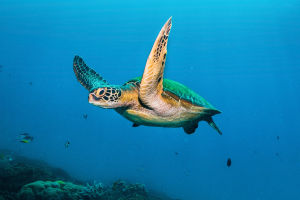Good day, Lykkers! Coral reefs are one of Earth’s most biodiverse ecosystems, teeming with an array of colorful and unique species.
The fish that call these reefs home play vital roles in maintaining the health of this delicate environment.
From cleaning the reef to protecting coral, each fish species contributes to the reef's dynamic balance. Below, explore five specific types of fish that thrive beneath the coral reefs and their important roles in the ecosystem!
1. Clownfish (Amphiprioninae): Symbiotic Relationship with Anemones
Clownfish are small, brightly colored fish that live in a mutually beneficial relationship with sea anemones, which offer protection with their stinging tentacles. Clownfish are immune to the venom of the anemones due to a special mucus coating on their skin. In return, clownfish help clean the anemones and protect them from potential predators, such as butterfly-fish.
Clownfish are also vital for the reef's food chain, feeding on smaller invertebrates that can otherwise overrun the reef. These fish are found predominantly in the Indo-Pacific and parts of the Red Sea, often around shallow, sheltered reefs.
2. Parrotfish (Scaridae): Natural Reef Cleaners
Parrotfish are essential to coral reef ecosystems due to their role in grazing on algae. They use their strong, beak-like teeth to scrape algae from the surface of coral and rocks, preventing algae overgrowth, which could otherwise suffocate the coral. Parrotfish are particularly important in the Caribbean, where coral reefs are highly vulnerable. Their feeding also helps to maintain a clean and healthy reef.
Parrotfish are often seen in large schools and are known for their vibrant colors, with species like the rainbow parrotfish displaying stunning hues. The digestion process of parrotfish even contributes to the creation of sandy beaches, as they break down coral into fine particles.
3. Lionfish (Pterois): Invasive Predators
Originally from the Indo-Pacific, lionfish have become an invasive species in the Atlantic and Caribbean, where they pose a significant threat to local ecosystems. Known for their venomous spines and striking red-and-white striped bodies, lionfish are skilled predators that consume a wide range of fish and invertebrates, often outcompeting native species.
Their rapid reproduction and lack of natural predators in the Atlantic have led to a boom in their population, resulting in considerable damage to coral reef ecosystems. Their aggressive hunting practices reduce fish populations, which can have cascading effects on reef health. Efforts to control the lionfish population include spear fishing and promoting them as a sustainable food source.
4. Surgeonfish (Acanthuridae): Algae Grazers and Reef Protectors
Surgeonfish are another group of fish crucial for the health of coral reefs, primarily due to their role in algae control. Their sharp, scalpel-like spines near the tail allow them to defend themselves from predators. Surgeonfish, such as the popular regal blue tang (famously seen in the movie "Finding Nemo"), graze on algae growing on coral and rocks, preventing algae from overpowering the reef. Without these fish, algae could smother corals, blocking sunlight and hindering the reef's ability to thrive.
Surgeonfish are commonly found in the Indo-Pacific, particularly in areas like the Great Barrier Reef, where they help maintain a balance between coral and algae.
5. Damselfish (Pomacentridae): Territorial and Coral Protectors
Damselfish are small but highly territorial fish that play an important role in the protection of coral reefs. Often found in tropical coral habitats, these fish create and defend territories around specific patches of coral. Damselfish are known to aggressively protect their coral gardens from other species, including larger herbivorous fish that might consume the coral. Their presence helps prevent overgrazing and keeps the coral healthy.
Species like the azure damselfish are particularly famous for their vibrant blue coloration and their diligent efforts in maintaining their patch of reef. These fish are important for the long-term health of coral reefs, ensuring that specific areas of coral remain intact and well-maintained.
The coral reefs beneath the ocean's surface are incredibly diverse ecosystems, supported by a variety of fish species that each play unique and essential roles. Clownfish, parrotfish, lionfish, surgeonfish, and damselfish all contribute to the delicate balance required to keep these ecosystems thriving.
From maintaining healthy algae levels to protecting the coral itself, these fish species are not just beautiful to observe but crucial for the reef’s survival. Protecting the coral reefs and their inhabitants from threats like pollution, climate change, and invasive species is essential to ensuring that these ecosystems continue to flourish for generations to come!


